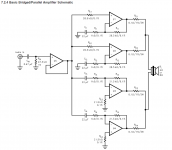I believe that the buffer opamp is used because it gives a constant stable low impedance output to all 4 lm3886 inputs , half of the LM3886 are inverted so the input impedance affects the gain of these amps so a buffer is needed to make sure the gain is stable on the inverted amps no matter what the output impedance of the source is .....
Never built a BPA but of the paralell and bridge amps i have built i found the paralell amps quite tricky to get right and very unforgiving and the bridge amps much easier to get right .......
Cheers
Never built a BPA but of the paralell and bridge amps i have built i found the paralell amps quite tricky to get right and very unforgiving and the bridge amps much easier to get right .......
Cheers
Is the datasheet BPA200 really a good design?
No, its not. But its not too hard to fix it up.
The primary reason why its bad is the 22uF capacitors. Electrolytics have tolerances such that the LF gain will not be sufficiently well matched in most instances - with the result that the paralleled amps will fight one another. Raising the value to 1000uF fixes this.
abraxalito,
Two questions in one then. What would be better the higher value capacitor or a close match of the capacitors at the low value. If this was within a much closer range would it solve the problem. Can a film capacitor be substituted for the electrolytic at 22uF ? Couldn't all of these capacitors be film capacitors where they are in this portion of circuit?
Two questions in one then. What would be better the higher value capacitor or a close match of the capacitors at the low value. If this was within a much closer range would it solve the problem. Can a film capacitor be substituted for the electrolytic at 22uF ? Couldn't all of these capacitors be film capacitors where they are in this portion of circuit?
Last edited:
Either would work fine - I just proposed the larger value because its cheaper and potentially smaller size. I have run a simulation on this in the past and I think you'd need better than 1% matching if using a 22uF, but my memory is hazy. No reason a film cap can't be used, no, just hard to find such close tolerances. Hand matching is an option too provided lack of stability over temperature and time doesn't compromise the matching.
The temperature stability of a cap is mostly down to the kind of dielectric used, not the voltage rating. Stability over time I don't know anything about - though I'd guess that winding tightness has something to do with it, meaning boutique-style audiophile caps would be worse.
As regards sound quality - again not much experience listening to caps - the only comparisons I have done are between film and NP0 in active XOs, where the NP0s won easily. My guess would be that the lower the voltage across a cap, the less it can affect the sound. But also smaller is better because a bigger cap picks up more RF hash and has higher series inductance meaning more chances of RF resonances.
As regards sound quality - again not much experience listening to caps - the only comparisons I have done are between film and NP0 in active XOs, where the NP0s won easily. My guess would be that the lower the voltage across a cap, the less it can affect the sound. But also smaller is better because a bigger cap picks up more RF hash and has higher series inductance meaning more chances of RF resonances.
So if I follow you correctly then the caps value should be close to the voltage rating of the circuit and not just some arbitrary high voltage. So a 50v cap would be good on a 35vdc circuit? And those boutique caps are so pretty......... I've seen normally produced caps made to look special by the fancy script printed and colored outside wrap while being exactly the same as a production film capacitor. Watched them being made once...
So if I follow you correctly then the caps value should be close to the voltage rating of the circuit and not just some arbitrary high voltage. So a 50v cap would be good on a 35vdc circuit?
Yes, I'm no fan of over-engineering. A higher voltage than necessary means a physically bulkier cap and that'll pick up more interference.
And those boutique caps are so pretty......... I've seen normally produced caps made to look special by the fancy script printed and colored outside wrap while being exactly the same as a production film capacitor. Watched them being made once...
My working hypothesis (in absence of listening comparisons) is that all that fancy packaging works as placebo
- Status
- This old topic is closed. If you want to reopen this topic, contact a moderator using the "Report Post" button.
- Home
- Amplifiers
- Chip Amps
- Datasheet BPA200 in practice
